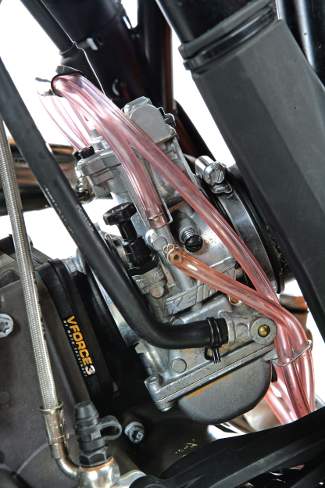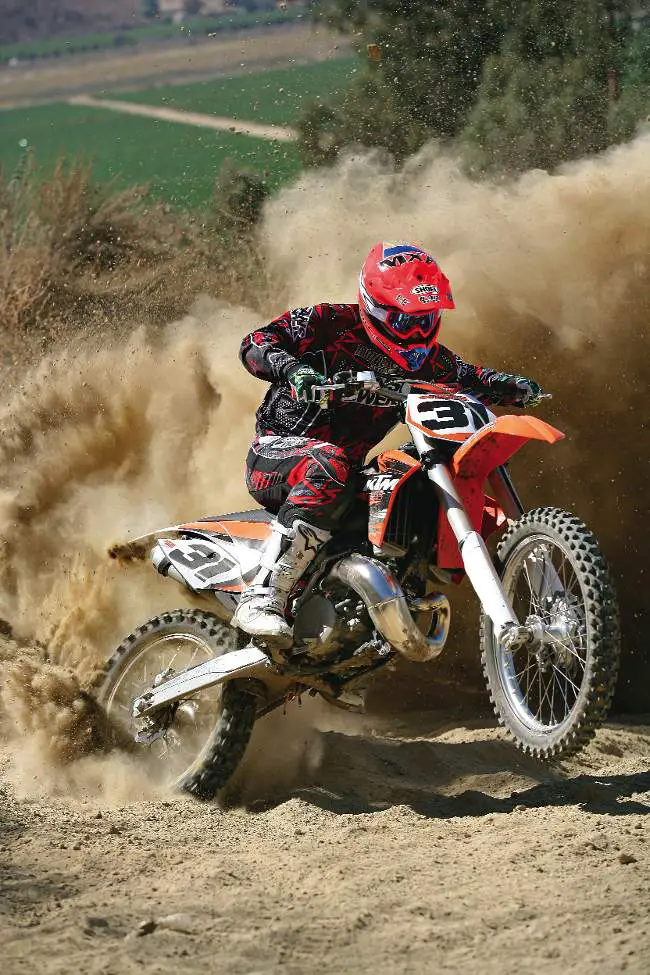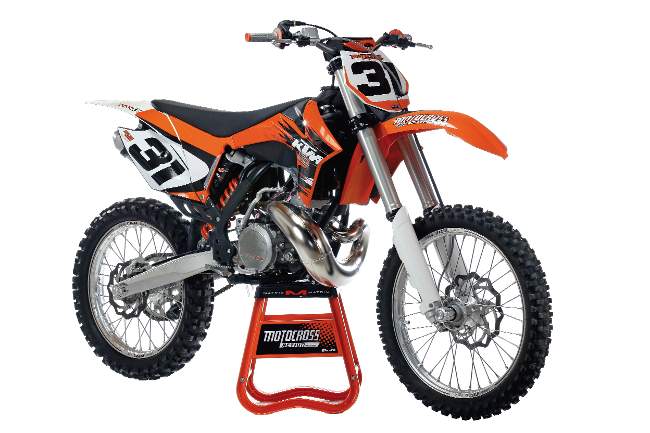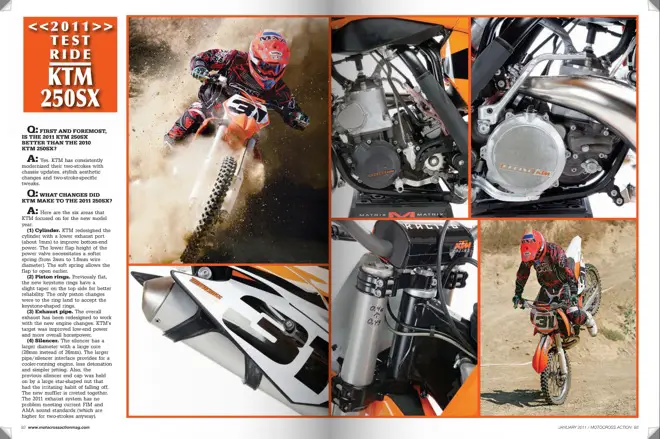2011 KTM 250SX MOTOCROSS TEST: NOT A WARMED-OVER BNG BIKE, BUT A TOTALLY NEW TWO-STROKE FOR THE NEXT GENERATION

Q: FIRST AND FOREMOST, IS THE 2011 KTM 250SX BETTER THAN THE 2010 KTM 250SX?
A: Yes. KTM has consistently modernized their two-strokes with chassis updates, stylish aesthetic changes and two-stroke-specific tweaks.
Q: WHAT CHANGES DID KTM MAKE TO THE 2011 250SX?
A: Here are the six areas that KTM focused on for the new model year:
(1) Cylinder. KTM redesigned the cylinder with a lower exhaust port (about 1mm) to improve bottom-end power. The lower flap height of the power valve necessitates a softer spring (from 2mm to 1.8mm wire diameter). The soft spring allows the flap to open earlier.
(2) Piston rings. Previously flat, the new keystone rings have a slight taper on the top side for better reliability. The only piston changes were to the ring land to accept the keystone-shaped rings.
(3) Exhaust pipe. The overall exhaust has been redesigned to work with the new engine changes. KTM’s target was improved low-end power and more overall horsepower.
(4) Silencer. The silencer has a larger diameter with a larger core (28mm instead of 26mm). The larger pipe/silencer interface provides for a cooler-running engine, less detonation and simpler jetting. Also, the previous silencer end cap was held on by a large star-shaped nut that had the irritating habit of falling off. The new muffler is riveted together. The 2011 exhaust system has no problem meeting current FIM and AMA sound standards (which are higher for two-strokes anyway).
(5) Silencer mount. The silencer’s wraparound mounting system is designed to allow more flex with less chance of cracking and damage. This style of silencer bracket would melt on a hotter-running four-stroke.
(6) Shock. The single-side, no-link, WP shock is 11mm longer and has 5mm more shaft travel than last year’s shock. The rear wheel travel stays the same because the angle of the shock has been altered to change the rising rate. In effect, KTM made the suspension a little softer in the beginning of the stroke with a steeper rising rate. Their goal was to make it plusher with better bottoming resistance.
 |
| History lesson: Some day we’ll look back on the simplicity of two-strokes, carburetion and light weight as the glory days. |
Q: WHAT OTHER CHANGES WERE MADE TO THE KTM 250SX TWO-STROKE?
A: The six mods listed above are KTM 250SX-specific. The mods listed below were made to all of the motocross models?four-stroke and two-stroke.
(1) Frame. All of KTM’s motocross models offer all-new chromoly steel frames. The new frame structure is engineered to feed in more torsional rigidity and less longitudinal rigidity. The only difference between an SX two-stroke frame and an SXF four-stroke frame is the upper shock mount placement.
(2) Swingarm. KTM switched to a “single component casting process” that eliminates welding and lets them do more with the casting process to engineer in flex. We don’t know how it’s done, but the swingarm is one piece.
(3) Preload ring. The PDS shock is longer to offer improved rising-rate characteristics. It also has a new nylon shock preload ring.
(4) Fork settings. They have been adjusted for the chassis and rear suspension changes.
(5) Bodywork. The new bodywork was designed for sleek looks and good ergonomics with a handhold for lifting the bike. The rear fender is wider and longer.
(6) Air box. KTM redesigned their air boots and air boxes for each displacement model. The intake had been redesigned for better airflow (and more room for the new PDS shock angle).
(7) Wheels. The Excel rims are now silver instead of black. The spokes are zinc/nickel coated and attached with aluminum spoke nipples.
(8) Fuel tank. KTM had to redesign their fuel tanks to accept the electronic fuel injection fuel pump, but the non-EFI bikes don’t need the fuel pump.
Q: HOW FAST IS THE 2011 KTM 250SX?
A: KTM may have claimed improvements in the lower rpm range, but no MXA test riders felt that the bottom was significantly better. On the plus side, there was a more pronounced hit just short of the midrange.
Over the past few model years, the 250SX has had a very controllable transition into the sweet spot of the powerband. This metered power delivery made the 250SX easy to hook up and less prone to wheel spin. Test riders described it as “mellow” low-end power and always used the clutch to coax it into action. Not so on the 2011 250SX. The 2011 250SX jumps on top of soft dirt and pulls hard. It has the hit that the 2010 model lacked. The top-end power is good, and most test riders used all it had.
Q: HOW IS THE 2011 KTM 250SX JETTING?
A: We had no issues with jetting on the 250SX, save for the normal air screw adjustments for weather conditions and altitude. Here are MXA‘s recommended jetting specs (when changed, stock specs are in parentheses). Here’s what we ran:
Main: 158 main
Pilot: 42 pilot
Slide: 6.5 slide cut away
Needle: N1EI
Clip: 3rd from top
Air screw: 1-1/2 turns
Notes: Last year we went to a 40 pilot, but the engine mods seem to like the stock jetting this year.

With the additional of some basic two-stroke tuning tricks, you can get the KTM 250SX to pump out more than 50 horsepower.
Q: HOW DID THE 2011 KTM 250SX HANDLE?
A: If you are a four-stroke jockey (and have never raced a two-stroke), you are in for a surprise. It is amazing what a two-stroke can do in comparison to a stodgy thumper. The KTM 250SX was light, felt lighter and almost floated over jumps. Test riders could go wherever they wanted?and places they could never go on a four-stroke. Thanks to the light weight and snappy throttle response, a KTM 250SX is a thrill ride. A two-stroke feels like a Porsche after getting off of a Chevy Suburban-like four-stroke.
Q: WHAT WERE OUR BEST FORK SETTINGS?
A: The traditional complaint against WP forks has always been midstroke harshness, and although settings were revised, the forks are pretty much the same as last year. KTM’s suspension record is spotty. The biggest problem with the 250SX forks is tht they come with Euro-spec springs?too soft. Across the KTM line the forks vary considerably. The 450SXF has good settings, while the 250SXF is chronically harsh. As a rule of thumb, we typically up the spring rate and lower the oil height to hold the forks higher, allowing them to move more freely through the middle and still resist bottoming. For hardcore racing, we ran this setup on the 2011 KTM 250SX (stock clickers are in parentheses):
Spring rate: 0.46 kg/mm (0.44 kg/mm)
Oil height: 370cc (380cc)
Compression: 12 clicks out
Rebound: 9 clicks out (12 clicks out)
Fork leg height: 5mm up (flush on a sandy track)
Notes: KTM two-strokes are shipped to the U.S.A. with the European-spec spring rates. The 0.44 kg/mm fork springs are too soft for serious racing. We exchanged them for stiffer 0.46 springs.

Fun magnifier: Two-strokes are a blast to ride.
Q: WHY DIDN’T THE TWO-STROKES GET THE NEW SHOCK LINKAGE?
A: For 2011, KTM’s two-strokes and offroad/enduro models will retain the no-link PDS shock. KTM sincerely believes that the single-sided no-link system is better suited to the weight and feel of the two-stroke’s power delivery. In truth, they believe that the no-link idea worked well on all their bikes, but switched to linkage on the four-strokes to quell public anxiety. Despite years of criticism from others, the MXA wrecking crew thinks that KTM’s PDS system is very capable. Plus, the no-link, single-sided, PDS system is several pounds lighter than any linkage system.
All things considered, sticking with the PDS on the two-stroke was a good choice. The no-link system is considerably lighter, easier to work on, simpler to adjust and vastly improves ground clearance when casing jumps.
Q: WHAT WERE OUR BEST SHOCK SETTINGS?
A: We had some issues with the Euro-spec spring rate, but apart from a little busyness in the first quarter of the shock shaft stroke, we felt that the no-link was plusher than KTM’s linkage-equipped brothers. For hardcore racing, we ran this setup on the 2011 KTM 250SX (stock clickers are in parentheses):
Spring rate: 7.2 kg/mm (6.9 kg/mm)
Race sag: 105mm
Hi-compression: 1 turn out (1-1/2 turns out)
Lo-compression: 10 clicks out (15 clicks out)
Rebound: 18 clicks out (22 clicks out)
Note: If you are small and weigh under 170 pounds, try the stock 6.9 kg/mm spring before changing. We felt that the stiffer 7.2 kg/mm spring stopped the shock from wallowing in the first half of the stroke, allowed it to hold some travel in reserve for big bumps and fought off bottoming better.

With most 450 four-stroke pushing 245 pounds, the lightweight 250cc two-stroke is a breath of fresh air.
Q: HOW WAS THE GEARING?
A: In the past few years, test riders added a tooth to the rear sprocket to get more of a gun-and-run motocross power delivery. Some riders still chose to gear the 2011 KTM 250SX down, but the snappier power delivery of the new engine lessens the need to go lower.
Q: HOW DOES THE 2011 KTM 250SX STACK UP AGAINST 250, 350 AND 450 FOUR-STROKES?
A: Unlike its four-stroke competition, the 2011 KTM 250SX can be raced in the 250 class, 450 class or any Vet class. That makes it a versatile machine, but it also means that it faces a wider range of competition.
Against a 250 four-stroke: The 250SX is faster, more responsive and lighter feeling. In a drag race, it will win. In fact, in any head-to-head shootout against a 250 four-stroke, the KTM 250SX should always win. It’s that much better. It isn’t as tractable as a 250 four-stroke, but it is lighter and quicker.
Against a 350 four-stroke: The KTM 350SXF is supposed to be easier to ride, lighter and quicker than a heavier 450cc four-stroke. Paradoxically, some of the same things can be said about the 250SX in comparison to the 350SXF. The two-stroke makes more horsepower and weighs less. Depending on the dampness of the dirt, it could be easier or harder to ride?based on wheel spin.
Against a 450 four-stroke: The KTM 250SX two-stroke has a worthy opponent in the 450cc four-stroke. Although the two-stroke is lighter, it doesn’t have as much horsepower, torque or tractability as the four-stroke. It can beat a 450 four-stroke, but it isn’t a slam-dunk. And, you could say that in any head-to-head shootout against a 450 four-stroke, the 450 should always win.

2011 KTM 250SX: The two-stroke market is booming in Europe with a host of brands offering smokers in 125cc, 150cc, 250cc and 300cc versions. In the USA, only KTM takes the two-stroke market seriously, while Yamaha continues to offer a continuation of its 2007 bike.
Q: WHAT DID WE HATE?
A: The hate list:
(1) Ridability. We love the hit, but it took a little more seat time to learn to anticipate the violent power swings?especially after switching from a four-stroke.
(2) Rear fender. We like the body cladding design, but the rear fender does seem like overkill in width and length. Although the 250SX shares some plastic with its four-stroke stable mates, a close look will reveal parts that are special to the two-smoke.
(3) Refueling. It’s difficult to remove the locking gas cap, hard to see the fuel level in the shallow top tank, and easy to knock dirt down into the lipless opening. The MXA test riders have never liked black gas tanks; we would gladly accept the translucent plastic that the KTM EXCs use.
(4) Exchange rate. It takes more dollars to buy something made with euros. The good thing is that the 2011 250SX two-stroke’s suggested retail price is $2100 less than the 450SXF four-stroke and $1800 less than the 350SXF. The MSRP on the 250SX is $6699. That is $450 cheaper than the SRP of a Yamaha YZ250 two-stroke.

KTM’s unique plastic/nylon silencer bracket is a far cry from the old days of welded on aluminum tabs.
Q: WHAT DID WE LIKE?
A: The like list:
(1) Ground clearance. The 250SX two-stroke has 10mm more ground clearance than the 350/250 SXF and 14mm more than the 450SXF. We actually noticed the difference while riding before going back to look up the specifications. The smaller engine and lack of linkage raise the bottom of the bike enough that it doesn’t drag in deep ruts or case jumps
(2) Modernity. Sadly, most two-stroke guys are forced to race bikes that look very vintage. Not so with the 2011 KTM 250SX. The 250SX looks every inch like every other brand-new KTM.
(3) PDS shock. We’re glad KTM didn’t drop the technology completely. In truth, the difference between KTM’s linkage and no-linkage rear suspension just isn’t big enough to worry about.
(4) Powerband. It hits harder and feels racier than before.
(5) Brakes. KTM’s oversized Galfer/Brembo combo is impressive on a heavy four-stroke, so imagine what it feels like on a lightweight two-stroke.
(6) Noise. From far away, deep reverberating four-stoke engines are much louder than two-strokes. Close up, two-stroke sound effects are more satisfying. Under AMA rules, a 250cc two-stroke can make 96 dB, while a four-stroke can only make 94 dB (because the sound of a four-stroke carries twice as far as two-stroke sound). When you bench race, you probably describe throttle openings with a throaty two-stroke braapp, not a flatulent four-stroke blather. Two-strokes are ingrained in your mind.

Q: WHAT DO WE REALLY THINK?
A: To many, two-strokes may be ancient vehicles, but the 2011 KTM 250SX is no worn-out mail truck. It’s a modern, updated, full-on racing machine. From the chromoly steel frame to the PDS shock to the two-stroke engine, the KTM is a picture of lightweight simplicity and practicality. Plus, it hauls the mail.





Comments are closed.